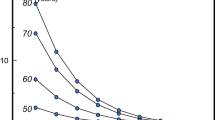Abstract
Osteoporosis is a growing problem in Asia, and early identification of at risk subjects for preventive measures is likely the most cost-effective method for managing this disease in developing countries. Patients with low bone mineral density (BMD) have a high risk of future fracture. However, access to BMD measurements is limited in many areas of Asia, and inexpensive methods of targeting high-risk patients for BMD measurements would be valuable. We compared two methods, a simple clinical risk assessment tool, the Osteoporosis Self-assessment Tool for Asians (OSTA), and quantitative bone ultrasound (QUS) in identifying subjects with low BMD by DXA in 722 southern Chinese postmenopausal women recruited from the community in Hong Kong. Using the published cutoff value of –1 (versus 0 or higher) for OSTA to identify subjects with femoral neck BMD T-score ≤−2.5, basing on our local population peak young mean value, the sensitivity and specificity was 88% and 54% respectively. The optimal cutoff T-score of –2.35 for QUS yielded sensitivity and specificity values of 81% and 65%, respectively. The AUC for QUS was 0.78, which was not significantly different from that of 0.80 for OSTA. Both OSTA and QUS correlated significantly with BMD at the femoral neck (0.62 and 0.36, respectively, P both <0.001). When these cut-off values were used to identify subjects with either lumbar spine or femoral neck BMD T-score ≤−2.5, the sensitivity and specificity was 79% and 60%, respectively, for OSTA, and 69% and 70%, respectively, for QUS. Combining QUS with OSTA improved the sensitivity to 91%, but the specificity was reduced to 44%. We conclude that the simple clinical risk assessment tool OSTA is a free and effective method for identifying subjects at increased risk of osteoporosis, and its use could facilitate the appropriate and more cost-effective use of bone densitometry in developing countries.
Similar content being viewed by others
References
Cooper C, Campion G, Melton LJ (1992) Hip fractures in the elderly: a worldwide projection. Osteoporos Int 2:285–289
World Health Organization (1994) Assessment of fracture risk and its application to screening for postmenopausal osteoporosis. WHO Technical Report Series 843, WHO, Geneva
Genant HK, Engelke K, Fuerst T et al. (1996) Noninvasive assessment of bone mineral and structure: state of the art. J Bone Miner Res 11:707–730
Njeh CF, Boivin CM, Langton CM (1997) The role of ultrasound in the assessment of osteoporosis: a review. Osteoporos Int 7:7–22
Gregg EW, Kriska AM, Salamone LM et al. (1997) The epidemiology of quantitative ultrasound: a review of the relationships with bone mass, osteoporosis and fracture risk. Osteoporos Int 7:89–99
Hans D, Dargent-Molina P, Schott AM et al. (1996) Ultrasonographic heel measurements to predict hip fracture in elderly women: the EPIDOS prospective study. Lancet 348:511–514
Bauer DC, Gluer CC, Cauley JA et al. (1997) Broadband ultrasound attenuation predicts fractures strongly and independently of densitometry in older women. A prospective study. Study of Osteoporotic Fractures Research Group. Arch Int Med 157:629–634
Koh LKH, Ben Sedrine W, Torralba TP, Kung AWC et al. (2001) A simple tool to identify Asian women at increased risk of osteoporosis. Osteoporos Int 12:699–705
Black DM, Palermo L, Abbott T, Johnell O (1998) SOFSURF: a simple useful risk factory system can identify the large majority of women with osteoporosis. Bone 23:S605
Cadarette SM, Jaglal SB, Kreiger N et al. (2000) Development and validation of the osteoporosis risk assessment instrument to facilitate selection of women for bone densitometry. Can Med Assoc J 162:1289–1294
Lydick E, Cook K, Turpin J et al. (1988) Development and validation of a simple questionnaire to facilitate identification of women likely to have low bone mass. Am J Man Care 4:37–48
Kung AWC, Tang GWK, Luk KDK, Chu LW (1999) Evaluation of a new calcaneal quantitative ultrasound system and determination of normative ultrasound values in southern Chinese women. Osteoporos Int 9:312–317
Geusens P, Hochberg MC, van der Voort DJM et al. (2002) Performance of risk indices for identifying low bone density in postmenopausal women. Mayo Clin Proc 77:629–637
Kung AWC, Luk KDK, Chu LW, Tang GWK (1999) Quantitative ultrasound and symptomatic vertebral fracture risk in Chinese women. Osteoporos Int 10:456–461
Njeh CF, Fuerst T, Dissel E, Genant HK (2001) Is quantitative ultrasound dependent on bone structure? A reflection. Osteoporos Int 12:1–15
Barkmann R, Heller M, Gluer CC 1996 The influence of soft tissue and waterbath temperature on quantitative ultrasound transmission parameters: an in vivo study. Osteoporos Int 6 (Suppl 1)
Hans D, Schott AM, Arlot ME, Sornay E, Delmas PD, Meunier PJ (1995) Influence of anthropometric parameters on ultrasound measurements of os calcis. Osteoporos Int 5:371–376
Cummings SR, Black DM, Thompson DE et al. (1998) Effect of alendronate on risk of fracture in women with low bone density but without vertebral fractures: results from the Fracture Intervention Trial. JAMA 280:2077–2082
McClung MR, Geusens P, Miller PD et al. (2001) Effect of risedronate on the risk of hip fracture in elderly women. Hip Intervention Program Study Group. N Engl J Med 344:333–340
Reginster J-Y, Kung A, Koh L et al. (2002) A simple chart for evaluating risk of osteoporosis in Asian women based on the osteoporosis self-assessment tool for Asians (OSTA). Osteoporos Int 13 (Suppl 3):S30
Acknowledgements
The authors thank the nursing and technical staff of the Osteoporosis Centre, Department of Medicine, Queen Mary Hospital for their assistance in carrying out this project and Mr. Stanley Yeung for analyzing the data. This study was supported by the Osteoporosis and Endocrine Research Fund, and the CRCG grant of the University of Hong Kong.
Author information
Authors and Affiliations
Corresponding author
Rights and permissions
About this article
Cite this article
Kung, A.W.C., Ho, A.Y.Y., Sedrine, W.B. et al. Comparison of a simple clinical risk index and quantitative bone ultrasound for identifying women at increased risk of osteoporosis. Osteoporos Int 14, 716–721 (2003). https://doi.org/10.1007/s00198-003-1428-x
Received:
Accepted:
Published:
Issue Date:
DOI: https://doi.org/10.1007/s00198-003-1428-x




